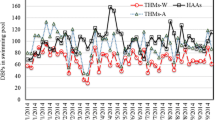Abstract
There are no recognized standards for recreational diving in benzene polluted waters. If daily absorption is limited to that absorbed from drinking 2-L of water at the recommended maximal contaminant limit concentration (9.7 μg per day), then permissible diving hours can be determined. A formula is proposed that calculates allowable monthly diving time based on dermal absorption, amount of water ingested, benzene concentrations in the water and in the sediment and the proportion of the body exposed.
Similar content being viewed by others
References
Albering HJ, Rila JP, Moonen EJC, Hoogewerff JA, Kleinjans JCS (1999) Human health risk assessment in relation to environmental pollution of two artificial freshwater lakes in the Netherlands. Environ Health Perspect 107:27–35
Amson JE (1991) Protection of divers in waters that are contaminated with chemicals or pathogens. Undersea Biomed Res 18:213–219
Heald PC, Schladow SG, Reuter JE, Allen BC (2005) Modeling MTBE and BTEX in lakes and reservoirs used for recreational boating. Environ Sci Technol 39:1111–1118
Lijzen JPA, Baars AJ, Otte PF, Rikken MGJ, Swartjes FA, Verbruggen EMJ, van Wezel AP (2001) Technical evaluation of the intervention values for soil/sediment and groundwater. National Institute of Public Health and Environment, Netherlands, RIVM report 711701 023
Schijven J, de Roda Husman AM (2006) A survey of diving behavior and accidental water ingestion among Dutch occupational and sport divers to assess the risk of infection with water borne pathogenic microorganisms. Environ Health Perspect 114:712–717
St Leger Dowse M, Bryson P, Gunby A, Fife W (2002) Comparative data from 2250 male and female sports divers: diving patterns and decompression sickness. Aviat Space Environ Med 73:743–749
U.S. ATSDR (Agency for Toxic Substances and Disease Registry) (2007) Toxicological profile for Benzene. US Department of Health and Human Services. Public Health Service. http://www.atsdr.cdc.gov/toxprofiles (assessed 1 November 2007)
U.S. EPA (U.S. Environmental Protection Agency) (1999) Extrapolation of the benzene inhalation unit risk estimate to the oral route of exposure. NCEA-W-05117 National Center for Environmental Health, Office of Research and Development, Washington, DC
U.S. EPA (U.S. Environmental Protection Agency) (2004) Risk assessment guidance for superfund. Volume I: Human Health Evaluation Manual (Part E, Supplemental Guidance for dermal risk assessment) Final EPA/540/R/99/005 OSWER 9285.7-02EP PB99-963312, Office of Superfund remediation and technology innovation. U.S. Environmental Protection Agency, Washington, DC
U.S. EPA (U.S. Environmental Protection Agency) (2005a) Integrated risk information system. Benzene (CASRN 71-43-2). Available: http://www.epa.gov/IRIS/ (assessed 1 June 2007)
U.S. EPA (U.S. Environmental Protection Agency) (2005b) Integrated risk information system. Chromium (VI)(CASRN 18540-29-9). Available: http://www.epa.gov/IRIS/ (assessed 1 June 2007)
U.S. EPA (U.S. Environmental Protection Agency) (2005c) Integrated risk information system. Toxicity and chemical-specific factors data base. Available: http://risk.lsd.ornl.gov/homepage/rap_cnt.shtml (June 2007)
U.S. NIH and NCI (National Institutes of Health, National Cancer Institute) (2007) Surveillance Epidemiology and End Results (SEER). SEER 17 registries 2002–2004. Available: http://seer.cancer.gov/faststat/ (June 2007)
Author information
Authors and Affiliations
Corresponding author
Rights and permissions
About this article
Cite this article
Froom, P. Proposed Method for Setting Standards for Recreational Divers Diving in Benzene Polluted Waters. Bull Environ Contam Toxicol 80, 251–254 (2008). https://doi.org/10.1007/s00128-007-9355-8
Received:
Accepted:
Published:
Issue Date:
DOI: https://doi.org/10.1007/s00128-007-9355-8




